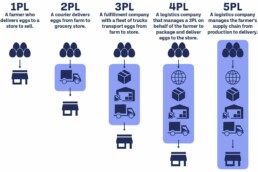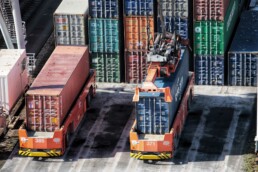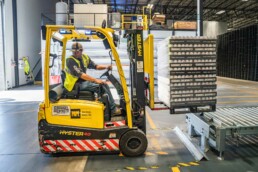Consider a 3PL Fulfillment Solution as Your Last Employee
The last employee your product sees, the 3PL fulfillment solution
For e-commerce businesses, order fulfillment can become complex and labor-intensive as your operations grow. While you scale up, it’s impractical and inefficient to handle all fulfillment in-house. This is where a third-party logistics (3PL) provider can act as your last employee – skilled specialists who manage your entire supply chain.
A good 3PL fulfillment solutions partner lifts the fulfillment burden off your shoulders so you can focus on high-level strategic decisions to grow your e-commerce business. In effect, they function as an extra department or employee that you don’t need to manage.
Benefits of Outsourcing Fulfillment to a 3PL Company
Here are some of the key benefits of using 3PL fulfillment solutions:
Access to Warehouses and Advanced Technology
A fulfillment company has warehouses optimized for e-commerce order processing with advanced inventory management systems. They invest in the best warehouse management systems (WMS), warehouse automation, and inventory tracking software so you don’t have to.
Lower Operational Costs
By leveraging the economies of scale from the 3PL’s network and consolidating your orders, you can reduce freight and shipping costs significantly. Things like cross-docking, order splitting, shipment consolidation and bulk shipping rates become possible.
Expert Shipping and Delivery Management
Get access to discounted shipping rates from carriers and optimized last-mile delivery solutions. A good provider has strong relationships with carriers and logistics partners to negotiate the best shipping prices.
High Quality Order Processing
With rigorous SOPs and KPI monitoring, 3PLs ensure quick turnaround times and excellent order accuracy. This improves customer satisfaction and allows you to scale order volumes rapidly.
Seamless E-Commerce Integration
Your web store or marketplace can be directly integrated with the 3PL’s order management system via API. As you grow sales channels, they can provide multi-channel fulfillment.
Improved Supply Chain Visibility
With their TMS platforms and inventory tracking software, you gain real-time visibility into your supply chain. See inventory levels, shipments in transit and delivery status updates for better planning.

How a 3PL Fulfillment Company Operates as Your Employee
When you engage a 3PL partner, you essentially add a entire logistics department to your organization. 3PL fulfillment solutions manage complex logistics processes end-to-end so you can focus on high-level business growth. Just like an employee, the 3PL fulfillment provider takes over these key operations:
Receiving and Managing Inventory
As shipments from suppliers arrive at their warehouse, they receive goods into inventory. This involves unloading, counting, inspecting and moving goods to storage locations. Some even provide VMI (vendor managed inventory) solutions where they directly interface with your suppliers to replenish stock levels automatically based on demand forecasts or inventory thresholds.
Storage, Handling and Inventory Tracking
Their fulfillment center has the specialized infrastructure to safely store goods for however long you require – whether its short-term storage during peak seasons or long-term storage of slow moving items. Inventory is accurately tracked at all times across barcode scans and cycle counts. Custom reporting provides inventory status updates.
Kitting, Bundling, Assembly and Packaging
Based on your BOMs (bills of materials) and product specifications, they can bundle items into kits, gift sets or combo packs. This light manufacturing also includes product assembly, attachments, inserts, customized packaging etc.
Order Processing and Fulfillment
As e-commerce orders come in, they handle the entire fulfillment process – picking, sorting, packing and shipping of orders with high accuracy. This involves outbound logistics like obtaining discounted shipping rates, optimizing delivery routes, interfacing with carriers for pickup and drop-off and tracking shipments.
Customer Service and Returns Handling
They field customer queries on order status updates, expected delivery dates and more so you don’t have to. For product returns and RMAs, they inspect returned items, process refunds or replacements and manage reverse logistics back into inventory.
Analytics and Performance Reporting
With their technology stack, they provide complete visibility into all key fulfillment metrics and KPIs through custom reports and analytics dashboards covering costs, order processing times, accuracy, capacity utilization etc.
Beginner’s Guide to Third-Party Logistics (3PL)
The world of e-commerce is always changing, therefore understanding the roll of Third-Party Logistics is integral to keeping up. In light of this our beginner’s guide to third-party logistics (3PL) will delve into the essential aspects, offering insights into fulfillment services, warehousing, and much more.
Read More…
As you can see a 3PL that specializes in e-commerce fulfillment provides end-to-end services that function like a logistics and supply chain department minus the overheads of managing resources in-house. Leveraging external specialists lets you scale faster by optimizing fulfillment costs and quality. Focus your efforts on sales, marketing and product development – the core of growing an e-commerce business.
Looking to find a 3PL fulfillment solution so you can focus on your business? Work with Falcon Fulfillment and get your time back.
Let’s Talk!
The Differences Between Logistic Types. Which is right for you?
The Differences Between Logistic Types: 1PL, 2PL, 3PL, 4PL, and 5PL.
Logistics management is an important component of any successful business. So you must choose the best logistics provider for your business to ensure your goods and services are delivered on time and at the right cost. Most people know about 3PL (third-party logistics), but there are several types of logistics providers. Understanding the differences between the different logistic types; 1PL. 2PL, 3PL, 4PL, and 5PL, can help you make the right choice for your business.
1PL, 2PL, 3PL, 4PL, and 5PL Defined

1PL
First-Party Logistics, or 1PL, is the most basic logistics provider. In this relationship, consisting of a supplier and retailer/customer, businesses use their resources to manage logistics and distribution. This may include hiring in-house staff, purchasing transportation, and leasing warehouses. Consequently, the shipping and receiving occur between the two parties involved, with no other middlemen involved in the process.
2PL
2PL stands for Second-Party Logistics and is an outsourced provider. In essence, Second-Party Logistics Providers focus solely on the transportation sector of business. For instance, examples of 2PLs include airlines, shipping lines, and hauling companies that operate vehicles. Notably, retailers that manage fulfillment in-house will often use a 2PL to deliver products to their final destination. As such, two prominent examples of 2PL providers are UPS and FedEx.
3PL
3PL stands for Third-Party Logistics and is a full-service provider. This logistics provider will handle all aspects of the supply chain, from warehousing to last-mile delivery. Services that a 3PL offers include; receiving, storing, packing, and shipping services. Some 3PLs, like Falcon Fulfillment, offer value-added services like inventory management, kitting and light assembly, and returns management.
According to Armstrong and Associates, 90% of Fortune 500 companies use a 3PL.
4PL
4PL stands for Fourth-Party Logistics and is a strategic partner that helps a business optimize its supply chain. This provider will help a company streamline its processes, reduce costs, and increase efficiency. 4PL providers are integrated into managing multiple aspects of the supply chain. Typically, 4PLs work like consultants who leverage relationships across 1PL, 2PL, and 3PL providers. They rely heavily on technology to optimize the logistics process, allowing them to offer a higher-level analysis of data and reporting. 4PLs provide everything a 3PL does but include project management, logistics negotiations, and strategy.
5PL
Finally, 5PL stands for Fifth-Party Logistics and is a logistics provider that works with multiple 3PLs to manage the entire supply chain. A Fifth-Party Logistics Provider is a consultant one step above a 4PL. 5PLs act as aggregators for 3PLs by bundling the needs of multiple 3PL businesses to get better service rates.
Differences Between Logistic Types: 1PL, 2PL, 3PL, 4PL, and 5PL Pros and Cons

1PL
If you are a small business with limited resources, then 1PL may be your best option. It is a simple system that makes it easy to manage. You have complete control over the logistics process. However, this system becomes limiting as you grow and can throttle business success.
2PL
Leveraging a shipping provider like FedEx, UPS, or USPS can provide a great network to ensure orders are received in a timely fashion. Using a 2PL provider is best for startups and organizations that can easily manage their fulfillment needs with in-house teams. However, one of the downsides to 2PL logistics is that it takes a very high quantity of shipments to earn volume discounts (a common benefit of 3PL partnership). Furthermore, 2PL relationships fail once orders overwhelm the existing team and warehousing space. If you spend more than 20% of your time fulfilling orders, it is probably a good time to outsource your logistics to a 3PL.
3PL
Using a 3PL provider is the sweet spot for many businesses because it allows companies to scale their sales, storage, and shipping efficiencies without adding tremendous overhead costs. When a company outgrows in-house fulfillment the logical next step is to partner with a 3PL. Conversely, if you have been partnering with a single 3PL and plan to launch internationally or would like to explore utilizing multiple 3PL relationships it is time to explore 4PL relationships.
4PL
Working with a 4PL has expansion possibilities beyond that of a single 3PL provider and can replace a logistics manager in-house. In fact, depending on your specific needs and order volume, this will determine if this additional layer of strategy is necessary to scale your business. However, with the additional expertise and data-driven insight comes additional costs as well.
5PL
Finally, working with a 5PL is typically reserved for large multinational retailers who have the order volume and capital to invest in logistics expansion. For most businesses the services provided by a 5PL are simply too expensive for their needs.
Beginner’s Guide to Third-Party Logistics (3PL)
The world of e-commerce is always changing, understanding the roll of Third-Party Logistics is integral to keeping up. This beginner’s guide to third-party logistics (3PL) will delve into the essential aspects, offering insights into fulfillment services, warehousing, and much more.
Read More…
It is important to research each type of provider to ensure you are getting a quality service that meets your specific needs. To the end, no matter which type of logistics provider you choose, it is essential to have a good understanding of your business’s requirements and goals and how they are met by what the provider offers. Ultimately, exploring the differences between 1PL, 2PL, 3PL, 4PL, and 5PL providers will help you select the right logistics provider to help your business succeed.
If you would like to learn more about how Falcon Fulfillment can help with your logistics needs, get in touch today.
Let’s Talk!
Managing Post-Holiday Returns in E-commerce Fulfillment
12 Strategies for Managing the Logistics of Returns After the Holiday Rush
The holiday shopping season always brings a major uptick in sales for e-commerce retailers. However, the other certainty about the holidays is that January inevitably brings a huge wave of product returns. In fact, Optoro estimates a massive $173 billion worth of holiday gifts were returned in 2023 alone!
As an e-commerce merchant, efficiently processing these high return volumes while keeping customers satisfied presents some major logistical and financial challenges. In this post, we’ll explore 12 fulfillment and reverse logistics tips to smooth out the post-holiday returns rush.
Accurately Forecast Return Rates
The first step is understanding your baseline return rates and how they fluctuate during the holiday peak. With this data in hand from past years, you can more precisely predict and plan for the upcoming returns influx. Being proactive also lets you strategically line up additional 3PL warehouse capacity or staffing to handle January order volumes.
Offer Free Returns
Our research shows 51% of customers will refuse to shop with an e-commerce merchant again if return shipping isn’t free. So offering free returns is critical, even though it eats into margins. Consider building estimated returns shipping costs into your base pricing structure to offset this.

Enable Online Return Requests
Allowing customers to instantly request and print return labels online makes processing returns quicker and more efficient for everyone involved. Customers appreciate the self-service convenience too. Integrating your order management system with your 3PL’s WMS platforms enables seamless return merchandise authorizations (RMAs).
Set Realistic Return Window Policies
Prominently display your returns policy and timeframe—whether 30, 60 or 90 days—across your website, especially at checkout. Be upfront so customers clearly understand the constraints before their purchase. However, also consider extending return windows over the holidays when gift-giving is common.
Set Realistic Return Window Policies
Thoroughly examine every return at your inbound processing facilities before reselling, discarding or refunding. This order quality control safeguards against reintroducing damaged inventory back into saleable stock. It also provides valuable product failure data to share with suppliers.

Improve Online Product Listings
For apparel brands, sizing issues are among the top reasons for e-commerce returns. Ensure your product detail pages display accurate garment measurements and size charts. For hard goods, precisely showcase dimensions, materials and colors with consistent, high-quality photography. Reducing disconnects between listings and actual items shipped curtails “not as described” returns.
Consider “Keep it” Discounts
Crunching the numbers may reveal that certain low-cost products are unprofitable to ship back through reverse logistics. One of the newer ways to manage holiday returns is to offer customers instant discounts—say 10-15%—if they simply keep the item instead of returning it. The customer saves on return hassles and you avoid transportation costs for that SKU.
Refine Demand Forecasting Inputs
Every e-commerce operation battles inventory inaccuracies between projected and actual demand. As returns roll in after the holidays, analyze which items are most commonly sent back due to excess stock that didn’t sell. Refine your demand planning models to better realign future purchase orders and safety stock levels with true consumer demand.
Renegotiate Carrier Return Rates
Don’t assume your 3PL’s outbound shipping contracts include the same rates for returns. Reverse logistics often command higher per-package rates. Reconfirm existing contracts or negotiate customized returns rates with your small parcel, LTL and FTL carriers to minimize transportation costs.
Centralize Returns at Regional Hubs
Consolidating returns processing at fewer, strategically located warehouse facilities increases efficiency through higher shipment volumes per inbound route. This lowers per-unit transportation costs considerably. It also lets you specialize staff that gain expertise handling returns at designated sites.
Explore New Resale Channels
Finding secondary markets to profitably liquidate all those returns is crucial. Consider Business to Business (B2B) bulk sales of written-off inventory to discount retailers or liquidators. Or develop new direct-to-consumer online outlets focused exclusively on selling refurbished or open-box items at a discount.
Analyze Root Causes
Finally, categorize and analyze why items were returned after the holidays. Identify products with repeated quality problems for remedial action. Spot trending characteristics of most returned SKUs to guide future product designs, forecasting and stocking decisions before next holiday season rolls around.
Beginner’s Guide to Third-Party Logistics (3PL)
The world of e-commerce is always changing, therefore understanding the roll of Third-Party Logistics is integral to keeping up. In light of this our beginner’s guide to third-party logistics (3PL) will delve into the essential aspects, offering insights into fulfillment services, warehousing, and much more.
Read More…
Implementing even a handful of these reverse logistics best practices will promote major post-holiday returns process improvements for your organization. Moreover, through elevated customer service levels and supply chain efficiencies, your enterprise can turn this yearly challenge into a competitive advantage. Partnering with an experienced 3PL provider equipped with the transportation, warehouse and staffing assets to flexibly scale is an invaluable asset too.
Let Falcon Fulfillment help you manage holiday returns. We can help you jump this hurdle and maximize your customer satisfaction and retention.
Let’s Talk!
Omnichannel Fulfillment - What Retailers Need to Know
Omnichannel Fulfillment – What retailers need to know.
As a retailer, staying ahead of the competition is an ongoing battle. Given that, one of the ways to stay ahead is to ensure that you are providing your customers with the best possible shopping experience. Subsequently that’s why omnichannel fulfillment is quickly becoming the go-to solution for many retailers.
Omnichannel fulfillment integrates the delivery of products to customers across various channels, encompassing in-store, online, and mobile app purchases. In light of this unified approach, customers receive a consistent shopping experience regardless of their chosen platform. Consequently, the significance of omnichannel fulfillment for retailers becomes evident. To optimize customer satisfaction, retailers must craft a comprehensive fulfillment strategy tailored to meet diverse shopping preferences. Delving into the intricacies of omnichannel fulfillment unveils crucial insights for retailers aiming to enhance their customers’ shopping journeys.
Know Your Customer

To ensure that you provide the best customer experience, you need to know who your customers are and their needs. This means that you must have a comprehensive understanding of their buying habits and preferences. Hopefully, you already understand who your customers are and what they are looking for, but here are some questions to consider as you build an omnichannel experience.
- Where does the bulk of your sales come from? Online? In-store? Via mobile app?
- What kinds of products are purchased via each channel?
- What are the age(s) and demographic of your primary buyers?
- Where do most of your buyers live?
- What marketing channels are having the most success in conversion and audience engagement?
Integrate Your Channels

To provide a seamless shopping experience, you must ensure that your channels are integrated. With this in mind you must have a unified platform that links all your channels, including your website, store, and mobile app. Key features to include in your omnichannel software programs are:
- A platform that can manage all the business’s channels, including order fulfillment, cross-channel marketing, and additional integrations like a CRM.
- Manage and combine customer-facing commerce channels. This would include all POS systems in-store, online, and via social media.
- Deliver functionality for B2C or B2B omnichannel commerce
- Maintain product availability and data across all channels.
If you work with a 3PL fulfillment partner, it’s crucial to first ensure that their software will integrate seamlessly with your platform. Otherwise, you may face significant challenges in managing your fulfillment process. However, if they, like Falcon Fulfillment, provide API integration tools and additionally offer an account manager to assist with implementation and integration, then you can proceed with confidence knowing that the transition will be smooth and efficient.
Streamline Processes

Because omnichannel fulfillment covers many systems, channels, and customers, creating workflows that cater to an excellent customer experience is crucial. Creating a smooth omnichannel fulfillment experience requires efficient processes. This includes automation and streamlining workflows. Start by reviewing business operations such as marketing and initial point-of-sale.
Utilize Technology

You must utilize the latest technology to ensure that you are providing your customers with the best possible shopping experience. Generally this includes using a customer relationship management (CRM) system to keep track of customer information, analytics to measure performance, and automation to streamline processes. Here are a few specific ways to streamline processes for omnichannel fulfillment:
- Automate Inventory management (more on this below)
- Use automation in managing the sorting, movement, storage, picking, and packing of retail orders for last-mile delivery
- Evaluate pick and pack procedures for inefficiencies
- Implement effective and easier returns management
Optimize Inventory

One of the most important elements of omnichannel fulfillment for retailers is optimizing inventory. You must have an effective inventory management system to provide your customers with the products they want when they want them. This includes having a real-time view of inventory so that you can quickly adjust your stock to meet customer demand. To this end, automation software, streamlined processes, and ensuring all systems integrate with real-time data help optimize the flow of goods in and out. Check out four ways a 3PL can help with outsourcing inventory management.
Beginner’s Guide to Third-Party Logistics (3PL)
The world of e-commerce is constantly evolving, and as such, understanding the role of Third-Party Logistics (3PL) is crucial for keeping up with the latest trends and best practices. In order to facilitate a comprehensive understanding of this critical aspect of e-commerce, this beginner’s guide to third-party logistics (3PL) will delve into the essential aspects of the field. Throughout this guide, we will explore a range of topics, including fulfillment services, warehousing, and much more, thereby providing valuable insights for those seeking to optimize their e-commerce operations.
Read More…
Omnichannel fulfillment is quickly becoming the go-to solution for many retailers. For this reason, understanding the key elements of omnichannel fulfillment and utilizing the right technology and processes, you can ensure that you provide your customers with the best shopping experience. Here at Falcon Fulfillment, we specialize in omnichannel fulfillment. We provide 7-day operations, 99.9% order accuracy, and automated inventory management. We don’t believe in a one-size-fits-all approach but believe that a seamless partnership and integration are essential to success.
If you want to learn more about how Falcon can help with your omnichannel fulfillment process, talk to one of our agents today.
Let’s Talk!
Building E-commerce Infrastructure Solutions For Scaling
Building E-commerce Infrastructure That Scales: Solutions for Growth
For e-commerce businesses aiming to scale up operations, generally, the presence of the right infrastructure is crucial. Overall, this infrastructure encompasses all the tools, technologies, facilities, and services essential to run an online retail business – ranging from storefront setup to order delivery.
As your e-commerce venture expands and order volumes surge, ensuring your infrastructure’s robustness and flexibility becomes imperative. At this point, investing in scalable infrastructure enables your business systems and processes to seamlessly adapt to evolving demands. Moreover, it prepares you for the future, facilitating the onboarding of more customers, exploration of new markets, and the launch of additional product lines.
This article provides insights and tips on constructing a future-ready e-commerce infrastructure capable of scaling alongside your business growth.
Robust E-commerce Technology Stack

The technology powering your online store and back-end operations stands as the foundation of your e-commerce infrastructure. As your order processing capabilities and inventory scale up, it’s crucial to ensure that your tech stack can adeptly support higher volumes without crashing.
Some key elements of a scalable e-commerce technology setup include:
- E-commerce Platform – An enterprise-grade platform like Shopify Plus or Magento can smoothly handle large catalogs, high traffic and order volumes. They offer flexible hosting, built-in analytics, scalable databases, CDNs, caching, etc.
- Order Management System (OMS) – A robust OMS seamlessly manages order processing across channels. It should easily integrate with other systems like your e-commerce platform, ERP, warehouses and 3PLs.
- Warehouse Management System (WMS) – An advanced WMS gives you real-time inventory visibility and scalable order fulfillment across multiple warehouses. Systems like Logiwa offer clear workflows, wave planning and labor tracking.
- SEO and Hosting – Invest in managed enterprise SEO and ultra-fast web hosting (with auto-scaling) to handle increasing visitors and conversions. Use a CDN like Cloudflare for faster load times.
These best-in-class technology systems will cost more upfront but deliver the scalability and performance needed to grow your e-commerce infrastructure solutions.
Order Fulfillment and Logistics

For online retailers, order fulfillment and shipping constitute a substantial portion of operations and costs. As your business scales, you require flexible solutions capable of managing double-digit order growth month-on-month.
Transitioning to an in-house fulfillment operation necessitates substantial upfront and ongoing investments in real estate, infrastructure, labor, and technology. However, opting to partner with a third-party logistics (3PL) provider offers immediate scalability to address seasonal peaks and accommodate sales growth.
Here are some tips for setting up scalable fulfillment and shipping with a 3PL partner:
- On-Demand Warehousing – Cloud warehouses provide you pay-as-you-go storage space that automatically adjusts to your inventory needs. This saves fixed infrastructure costs while offering unlimited room to stock more inventory as you grow.
- B2C Delivery Network – Select a 3PL with an extensive delivery network covering your target regions. This ensures speedy B2C shipping and returns even as your customer base expands geographically.
- Order Volume Ramp-Ups – Have open conversations with prospective 3PL partners regarding your current and projected order volumes. Confirm they can smoothly handle 10X or 100X spikes during peak or as you grow.
Overall, partnering with a top-tier 3PL like Falcon Fulfillment provides you the technology, infrastructure, delivery capacity and accountability needed to rapidly scale your store order fulfillment.
Inventory and Demand Planning

For on-time order delivery, you need sufficient inventory to meet customer demand – today and in future. Inventory planning, forecasting and optimization are crucial to scale up e-commerce operations profitably.
Start with safety stock planning to determine minimum inventory levels needed to meet baseline demand and seasonal fluctuations. Take upcoming promotions and new product launches into account as well.
Next, build data models using historical sales data, trends and external signals like holidays, competitor promotions, etc. Also develop rolling forecasts to predict demand changes and optimally scale up stock inventory.
Continuously track fulfillment metrics like order cycle times, stockout instances and excess reserves. In addition, maintain healthy fill rates based on your goals for order accuracy and on-time shipment rates.
As you grow, regularly evaluate inventory policies and restocking models. Make data-backed decisions on whether to scale through physical warehouse expansion or just-in-time inventory via dropshipping.
Overall, leveraging data, analytics and the expertise of a 3PL partner will enable you to fluidly align supply and demand. This is key to managing inventory costs while building e-commerce infrastructure solutions.
Building Strategic 3PL Partnerships

Given today’s supply chain disruptions and labor shortages, as a result, developing strategic partnerships is necessary for long term e-commerce success. But choosing the right partners can get overwhelming with so many 3PLs now offering branded D2C solutions.
Here are some tips on finding 3PLs to provide scalable infrastructure and services while saving you time as you grow your online business:
- Omnichannel Order Fulfillment – Seek 3PLs equipped to handle omnichannel processing and complex order orchestration across your website, retail stores, marketplaces and more.
- Pay-As-You-Go Pricing – On-demand fulfillment solutions let you easily scale up or down based on real-time business needs rather than forecasts. There are no fixed monthly costs or commitments.
- Best-In-Class Technology – Choose a partner offering cloud-based Warehouse Management Systems (WMS), intuitive dashboards and EDI integrations with major e-commerce platforms and sales channels.
- End-To-End Services – Look for 3PLs offering a wider range of value-added services (VAS) beyond the core warehousing and shipping capabilities. This saves additional integration and vendor management effort as you scale.
Establishing win-win, trust-based relationships with providers powering critical business functions is key for sustainable long term growth. Taking the time to vet and onboard the right technology and logistics partners will pay dividends as your e-commerce infrastructure solutions expand.
Beginner’s Guide to Third-Party Logistics (3PL)
The world of e-commerce is always changing, understanding the roll of Third-Party Logistics is integral to keeping up. This beginner’s guide to third-party logistics (3PL) will delve into the essential aspects, offering insights into fulfillment services, warehousing, and much more.
Read More…
Building scalable infrastructure is imperative for e-commerce businesses aiming for long-term growth and profitability. By investing upfront in flexible technology solutions, strategically partnering with 3PLs for order fulfillment, and taking a data-driven approach to inventory planning, you can continuously scale up operations to handle double or triple-digit order volume growth.
Remember that scale comes with its own challenges. So focus on actionable metrics like order cycle times, on-time shipments, inventory turnover rates and fill rates. Keep optimizing based on bottlenecks while maintaining profit margins and high customer satisfaction.
With the right foundation and expert partners supporting your systems and processes, your e-commerce business can successfully evolve from a seed round startup to a Series C unicorn venture.
Let’s Talk!
Inbound and Outbound Logistics - What you need to know
Inbound and Outbound Logistics
Logistics coordinates and moves resources – people, materials, inventory, and equipment – from one location to storage at the desired destination. It is the process of doing this. Regarding e-commerce, logistics management involves a significant aspect of business operations. Furthermore, logistics is a considerable expense, with businesses spending more than $1.64 trillion on logistics-related activities last year alone. What are the main differences between inbound and outbound logistics? What are the main challenges, and how can streamlining logistics benefit your business? This text and more will cover all this, read on!
Inbound vs. Outbound Logistics
Inbound logistics refers to where goods and materials enter the supply chain to sell to the customer. Outbound logistics refers to the process where the company sells and delivers the finished products to the customer. Streamlining both aspects of logistics is crucial to the company’s profitability and success.

What is outbound logistics?
Outbound logistics involves storing and moving goods to the customer or end user. Outbound logistics includes the systems required to prepare, pack, and deliver packages. The steps include order fulfillment, packing, shipping, and customer service related to delivery.

Warehousing
In order to meet customer demands, an e-commerce business needs a warehouse or storage facility to store surplus inventory. The US Business Inventory/Sales Ratio is 1.33, up from 1.26 last year. You can store your inventory in your own warehouse or partner with a third-party provider. Warehousing is a significant expense for e-commerce businesses. Whether you outsource your warehouse needs or handle them in-house, it is a crucial part of outbound logistics.
Inventory Management
Most e-commerce companies use inventory management software to maintain a consistent flow of orders and sales. Inventory management involves carrying adequate levels of stock to fulfill customer orders. It is a vital part of business management because it allows companies to boost profits and reduce overhead. There are many benefits to employing an automated inventory management system, including improved accuracy and better transparency. Inventory management also includes:
- Product locations
- Quantities of each product type
- Profit margin by style, model, product line, or item
- Setting the ideal amount of inventory to have in back stock and storage
- How many products to reorder and how often
- When to discontinue a product
Streamlined inventory management can boost profitability and improve customer experience. It allows you to capture and fulfill every sale while simultaneously avoiding overstock.
Order Processing
When a customer orders through the sales channel, a notification is sent to the warehouse for fulfillment. The staff in the warehouse receives the order and verifies its validity. They ensure the product(s) are in stock and can be made ready to send out to the customer.
Picking, Packing, and Kitting
All items are packaged, sealed, and labeled for shipment at this stage. Once an order is received and verified, the order has to be carefully picked, packed, and prepped for transport. Some items or orders, like subscription boxes, also require kitting services, where more than one product is carefully assembled into one shipment or package.
Transportation
Transportation involves any method or mode to move goods from your storage warehouse to a carrier distribution center or direct-to-customer. When moving goods to a distribution center or fulfillment facility, larger vehicles like freight carriers, semi-trucks, and rail lines are used. Then products are separated into smaller vans or vehicles to be delivered to the end consumer.
Last Mile Delivery
The final aspect of outbound logistics is the last-mile delivery to the end customer. Whether the package is delivered to a home or office, this is the culmination of the logistics journey. If the final delivery is unsuccessful or the product arrives damaged, the product may be returned, triggering an inbound logistics process (returns).
What is inbound logistics?
Inbound logistics is when a company secures raw materials, goods, and supplies to produce products it will sell to an end consumer. It is the receiving or incoming part of the supply chain cycle. A few of the critical components of inbound logistics include:

Sourcing and Purchasing
Inbound logistics starts with identifying the materials, goods, or supplies needed to build your product. Next, research potential manufacturers or suppliers of those goods or materials. Once you’ve identified suitable partners, engage with them directly to purchase and receive the materials. Maintain accurate records from purchase orders to ensure smooth reconciliation with shipments.
Transportation
When a manufacturer/vendor ships goods, they provide a notification. This notification includes a tracking number, which helps warehouse and distribution teams prepare for the efficient receipt of the items.
Receiving
First and foremost, this part of inbound logistics involves receiving shipments at the warehouse or distribution center. Loading dock staff then evaluate the shipment for damages and accuracy. Once the shipment is approved, the goods are stored in a designated storage facility or moved to a secondary manufacturing or assembly area. Finally, all goods ready for customer sales are input into the inventory management system and stored carefully.
Each step plays a crucial role in ensuring the smooth flow of goods and materials throughout the organization. Receiving shipments efficiently and accurately is essential for maintaining optimal inventory levels and meeting customer demand.
Reverse Logistics
The final aspect of inbound logistics occurs after a sale. Reverse logistics includes adding products back into the supply chain due to a product return. Check out 4 Ways to Streamline Returns Management.
Challenges of Inbound and Outbound Logistics

Inbound logistics challenges
The main challenges of inbound logistics include the following:
- Finding reliable and trustworthy suppliers
- Sourcing affordable suppliers and manufacturers
- Balancing inflow and outflow of goods to maintain adequate materials without overstocking
- Managing transportation delays and boosting supply chain resilience
- Maintaining receiving and quality control processes
Outbound logistics challenges
The main challenges of outbound logistics include the following:
- Hiring quality staff to manage order processing
- Maintain order accuracy and efficiency
- Negotiating transportation and shipping contracts to keep costs low
- Meeting delivery timeline expectations
- Reverse logistics management and process
Benefits of optimizing logistics
Inbound and outbound logistics are necessary for business operations to run smoothly. Without products, there are no sales, and vice versa without sales. Therefore, inbound and outbound logistics must work together for optimum success. This text provides some ideas to optimize your logistics process.
Maintain optimal inventory levels
Having too much or too little inventory is not ideal. If you order too much inventory, then you risk paying high storage fees. If you order too little, you miss out on sales opportunities and risk disappointing customers. To maintain optimal inventory levels, you need to commit to regular inventory audits, offload slow-moving stock or deadstock, invest in items with higher turnover rates, and those products with higher margins. Successful companies regularly review demand forecasts and take physical stock counts. Striking the correct inventory levels will reduce overhead costs from storage, improve product performance and profitability, and improve procurement workflows.
Improve warehouse management
Implementing a streamlined warehouse management process reduces human error and will improve order accuracy, shipping efficiency and maximize storage utilization. Most companies use software programs that help to automate inventory levels, trigger reordering events, automate picklist creation, and track shipment deliveries.
Beginner’s Guide to Third-Party Logistics (3PL)
The world of e-commerce is always changing, understanding the roll of Third-Party Logistics is integral to keeping up. This beginner’s guide to third-party logistics (3PL) will delve into the essential aspects, offering insights into fulfillment services, warehousing, and much more.
Read More…
Partner with a 3PL to optimize logistics
If you spend more than 15% of your time managing your logistics, it might be time to investigate working with a 3PL. 3PLs partner with e-commerce businesses as experts who handle inbound and outbound logistics. They manage receiving, warehousing, negotiating with shipping carriers, and returns. Some 3PLs, like Falcon Fulfillment, can provide flexible inventory storage in their fulfillment centers.
Find out more about how Falcon Fulfillment can take the stress of managing logistics off your plate. Get in touch with one of our friendly agents today.
Let’s Talk!
Canada Post Strike Backlog: Challenges and Recovery Ahead
Canada Post Strike Ends—But Digging Out the Backlog Has Just Begun
The recent Canada Post strike may have ended, but the challenges of addressing the massive backlog have only just begun. Businesses and consumers alike are grappling with delays, affecting everything from e-commerce fulfillment to international shipping. As postal workers return to their duties, the road to recovery highlights the importance of efficient supply chain management and alternative fulfillment solutions.

A Rocky Return to Normalcy
After four weeks of halted operations, Canada Post faces a daunting task: processing millions of undelivered packages and letters. This backlog impacts various industries, including warehousing and distribution, as businesses scramble to meet customer expectations. The strike’s ripple effects underscore the need for robust order tracking and management systems to mitigate disruptions during such events.
Third-party logistics (3PL) providers have been instrumental in filling the gap. Companies relying on Canada Post have turned to alternative carriers like UPS and DHL, leveraging scalable fulfillment solutions to maintain on-time delivery for their customers. However, even with these measures, challenges persist.
The Impact on E-commerce and Beyond
E-commerce fulfillment has been hit particularly hard. Online retailers depend heavily on reliable shipping and delivery services to meet the demands of same-day and next-day delivery. With Canada Post’s services disrupted, businesses have had to explore cross-docking and bulk shipping options to keep their supply chains moving.
Moreover, fulfillment centers are under pressure to adapt. Many have ramped up warehouse automation and implemented advanced inventory tracking software to improve order accuracy and quality control. Despite these efforts, the backlog has exposed vulnerabilities in inventory management and fulfillment cost analysis.
Lessons Learned in Fulfillment and Logistics
The Canada Post strike serves as a stark reminder of the importance of supply chain optimization. Businesses can take several steps to safeguard against future disruptions:
- Diversify Carrier Options: Relying on a single carrier can be risky. Companies should establish relationships with multiple providers for greater flexibility.
- Invest in Technology: Cloud-based warehouse management systems (WMS) and transportation management systems (TMS) can enhance visibility and efficiency.
- Focus on Last-Mile Delivery: This critical stage of the supply chain often determines customer satisfaction. Partnering with reliable carriers and optimizing routes can mitigate delays.
Recovery Efforts Underway
Canada Post has announced plans to prioritize essential services, including passport deliveries, while gradually addressing the backlog. However, this process will take time, especially given the complexities of freight consolidation and customs brokerage for international shipments.
For businesses, maintaining transparency with customers is key. Clear communication about delays, combined with proactive solutions like dropshipping or vendor-managed inventory (VMI), can help mitigate customer dissatisfaction.
The Role of Third-Party Logistics Providers
3PL providers have emerged as heroes in this crisis, offering value-added services (VAS) like kitting and assembly, freight forwarding, and reverse logistics. Their ability to adapt quickly to changing circumstances has been a lifeline for many businesses. By leveraging 3PL technology solutions, companies can better manage inventory forecasting and demand planning, ensuring smoother operations even during disruptions.
Beginner’s Guide to Third-Party Logistics (3PL)
The world of e-commerce is always changing, understanding the roll of Third-Party Logistics is integral to keeping up. This beginner’s guide to third-party logistics (3PL) will delve into the essential aspects, offering insights into fulfillment services, warehousing, and much more.
Read More…
Moving Forward
As Canada Post works to restore normalcy, businesses must take stock of their supply chain resilience. The strike has highlighted the need for scalable fulfillment solutions, advanced order fulfillment metrics and reporting, and enhanced safety and security measures in warehousing.
While the Canada Post strike may be over, the journey to recovery has just begun. Businesses must adapt, innovate, and invest in robust logistics strategies to navigate the challenges ahead. By doing so, they can not only survive but thrive in an increasingly complex and interconnected world of fulfillment and logistics.
Looking for more guidance on shipping?
Let’s Talk!
Why Companies Use 3PL Providers
Why Companies Use Third-Party Logistics (3PL) Providers and the Benefits
Outsourcing fulfillment and supply chain operations to a third-party logistics (3PL) provider offers numerous benefits for companies seeking to optimize their warehousing, distribution, inventory management, and overall logistics performance. Specifically, as the supply chain grows more complex, many businesses find it advantageous to leverage the expertise of 3PLs to handle logistics functions so they can focus on core competencies.
What is a 3PL?

A third-party logistics provider manages warehousing, transportation, freight forwarding, order fulfillment, reverse logistics, and other supply chain activities on behalf of client companies. Rather than handling these complex logistics operations in-house, businesses outsource them to 3PLs that have the advanced technology, extensive carrier relationships, and supply chain know-how to expertly coordinate global shipping, inventory management, and multi-channel order processing. These considerations are why companies use 3pl providers instead of trying to manage all these functions on their own.
As specialists in warehousing, distribution, and transportation solutions, 3PLs enable companies to scale operations, enter new markets, and meet customer delivery expectations in a dynamic business landscape. They provide flexible, scalable fulfillment and shipping solutions tailored to each company’s requirements.
Benefits of Using a 3PL Provider

Reduce Logistic Costs
By leveraging the economies of scale 3PLs enjoy from working with multiple clients, businesses can reduce overall logistics costs associated with operating their own fulfillment centers and managing transportation. In addition, outsourcing to 3PL providers also converts fixed costs into variable costs, resulting in a more predictable, cost-efficient model.
Access Advanced Technology
Top 3PL providers offer cutting-edge warehouse management systems (WMS), transportation management systems (TMS), inventory management software, and other technology to gain end-to-end visibility and control across the supply chain. This technology is invaluable for forecasting, inventory optimization, and providing exceptional customer experiences.
Focus on Core Business
Rather than directing valuable resources toward managing logistics operations, companies can shift focus to critical functions like production, marketing, and product development by partnering with a 3PL provider. The 3PL becomes an extension of their business, handling vital but non-core supply chain activities.
Improve Customer Service
By leveraging 3PL transportation networks and technology solutions, businesses can ensure on-time order delivery, provide real-time shipment tracking and visibility, process returns, and enable emerging delivery options to effectively serve customers. They also gain access to additional services like kitting and assembly.
Enter New Markets
3PL providers empower businesses to expand into new domestic and international markets by handling complex import/export processes, customs brokerage, final-mile delivery to global locations, and localization expertise to navigate regulatory environments. Their global warehouse networks and logistics capabilities facilitate scalable market growth.
Meet Customer Expectations
Today’s on-demand economy requires fast, flexible delivery options. So, 3PLs enable businesses to provide same-day and next-day shipping capabilities to meet and exceed rising customer expectations. Additionally, their technology also supports real-time order tracking and visibility.
Improve Supply Chain Agility and Resilience
By coordinating transportation across extensive carrier networks, 3PL providers enhance overall supply chain resilience for clients. Their ability to quickly reroute shipments and leverage alternative solutions prevents disruptions to inventory and order fulfillment flow. They add flexibility and continuity that supports growth.
How 3PL Providers Streamline the Supply Chain

One of the reasons why companies use 3pl providers is to help with supply chain management. Through technologically advanced, strategically located fulfillment centers, 3PL providers offer warehousing, pick/pack processes, kitting and assembly, and value-added services to swiftly fulfill online orders, retail replenishment orders, and manufacturing production orders. They also split large orders as needed to optimize transportation.
Shipment Consolidation and Distribution

To maximize transportation efficiency, 3PL providers consolidate less-than-truckload (LTL) shipments from multiple clients into full truckloads. They also optimize delivery routes, leverage aggregated volumes for lower shipping rates, and handle global distribution challenges. This reduces freight costs and environmental impact.
Real-Time Tracking and Visibility

Utilizing shipment tracking interfaces and supply chain data analytics, 3PL customers can closely monitor order status across the fulfillment lifecycle for this purpose. This includes inbound inventory to warehouses, order processing stages, carrier status updates, and final delivery. Enhanced visibility facilitates proactive issue resolution.
Reverse Logistics and Returns

Returns processing and reverse logistics present significant challenges, especially for e-commerce businesses. For those reasons, 3PL providers simplify, accelerate, and reduce costs associated with RMA approvals, refunds/replacements, transporting returned items, inspecting for damages/defects, and managing asset recovery.
Beginner’s Guide to Third-Party Logistics (3PL)
The world of e-commerce is always changing, understanding the roll of Third-Party Logistics is integral to keeping up. This beginner’s guide to third-party logistics (3PL) will delve into the essential aspects, offering insights into fulfillment services, warehousing, and much more.
Read More…
Choosing the Right 3PL Partner
With an array of 3PL providers to choose from, conduct thorough research to select one that best matches your business requirements, operational workflows, technology needs, inventory profiles, transportation lanes, and customer expectations. In essence, carefully assess their range of supply chain services, existing client base, customer service standards, operational performance metrics, stability and years in business, advanced technology capabilities, and global warehouse footprint. This helps ensure an excellent long-term strategic partner to streamline your supply chain.
Ready to add professional support to your workflow?
Let’s Talk!
3 Keys to Improving Your E-commerce Fulfillment Process
3 Keys to Improving E-commerce Fulfillment Process
As an e-commerce business, your fulfillment process is one of the most important factors in your success. Ultimately poor fulfillment can lead to dissatisfied customers, lost inventory, and financial losses. In contrast a well-designed and optimized fulfillment process can improve customer satisfaction and ensure your business runs smoothly. Here are 3 keys to improve your e-commerce fulfillment process:
1 – Have a Clear Fulfillment Strategy:

A clear fulfillment strategy will ensure that your products are delivered on time, in good condition, and that your customers get the best possible experience. A good plan will involve selecting a method for order fulfillment that is cost-effective, flexible, and meets the needs of your existing customers. When determining which fulfillment strategy is best, it is crucial to consider future growth. Here are the main types of e-commerce fulfillment strategies:
Merchant Direct Fulfillment
Merchant direct fulfillment, also known as in-house fulfillment, is best for small to medium-sized businesses with lower sales volumes. In general the benefits of this strategy include lower fulfillment costs (you only pay for shipping), complete control over the entire process, and the ability to add personalized touches to orders (hand-written thank-you notes, etc.). Conversely, the drawbacks of in-house fulfillment are that it is time-consuming, you often pay higher shipping premiums with lower order volumes, and human error is common.
Dropshipping
Dropshipping is a fulfillment strategy where the entire process is hands-off. E-commerce brands that use dropshipping can select, package, and ship their products directly to customers without ever having to handle the physical inventory in-house. This is a very effective strategy for start-ups with limited resources. The benefits of dropshipping are it takes very little upfront capital to get started, the manufacturer or vendor handles inventory management, and it is easy to market test new products. The limitations of dropshipping are lower profit margins, lack of inventory control, higher shipping costs, and delivery delays are frequent.
Third-Party Fulfillment (3PL)
Like dropshipping, the 3PL fulfillment strategy takes most of the headaches of shipping orders off your plate. In essence this strategy involves partnering with a third party that handles everything from receiving, storing, inventory tracking, picking, and packing to last-mile delivery. In addition, some 3PL companies even offer value-added services like returns management. The benefits of working with a 3PL to improve your e-commerce fulfillment include gaining insight and expertise, saving time and money, flexibility to scale for seasonal sales cycles, and improved customer satisfaction. In contrast, the drawbacks of 3PL fulfillment include added costs, finding a reliable partner can be difficult, and sometimes customer service issues can become complicated.
2 – Streamline Your Processes:

Streamlining the e-commerce order fulfillment process is essential for businesses aiming to increase efficiency and customer satisfaction. Automating processes, optimizing warehouse layout, and integrating inventory and shipping systems are some of the best tactics to streamline the order fulfillment process. Here are a few others:
- Automated Inventory Management
- Integrated Omnichannel technologies
- Multi-site distribution centers
- Optimized warehouse layouts and workflows
- Reduce manual processes when possible
3 – Consider Outsourcing:

Outsourcing e-commerce order fulfillment can be a great way to improve efficiency. Overall this process involves having a third-party logistics provider manage the inventory, packing, and shipping of orders for a business. It can enable companies to access warehouses and the latest technology to fulfill orders quickly and accurately. Outsourcing fulfillment can also allow businesses to focus on other vital areas, such as marketing, customer service, and product development. Additionally, outsourcing fulfillment can save money on labor costs, reduce their carbon footprint, and improve customer service. When looking for an outsourcing partner, select one with experience in e-commerce fulfillment that aligns with your business’s values.
Beginner’s Guide to Third-Party Logistics (3PL)
The world of e-commerce is always changing, understanding the roll of Third-Party Logistics is integral to keeping up. This beginner’s guide to third-party logistics (3PL) will delve into the essential aspects, offering insights into fulfillment services, warehousing, and much more.
Read More…
Following these 3 keys to improving the e-commerce fulfillment process will ensure your company is optimized for success. Regardless whether you are a small startup or a growing business with skyrocketing sales, a well-designed process will help to keep your customers satisfied and ensure that your business runs smoothly. Here at Falcon Fulfillment, we are fulfillment experts. Our goal is to provide personalized partnerships to each of our clients.
If you want to learn more about how working with Falcon Fulfillment can help streamline your fulfillment, reach out to one of our agents today.
Let’s Talk!
E-commerce Delivery Speed: Meeting Customer Expectations
E-commerce Parcel Delivery Speed: Meeting Customer Expectations
Fast e-commerce parcel delivery speed has become the norm in retail, led by Amazon and big box players. But attempting to compete on speed can negatively impact profits for smaller online sellers. Understanding what delivery times truly matter to your customers is key.
What’s more important than fast delivery is fulfilling expectations set through your brand promise and aligning services accordingly. Meeting delivery estimates accurately is better than promising unrealistically fast service. Optimizing order fulfillment starts with understanding real consumer preferences.

Consumer Preferences: Cheap and Free Over Fast
Despite the race for faster delivery, price and free shipping still reign supreme for most online shoppers over speed. Research shows the top reasons for buying directly from a brand are better pricing and free delivery rather than fastest delivery. Particularly with commoditized products, consumers will opt for longer transit times to reduce costs.
Sustainability concerns also play a role. More customers choose reduced emissions over fast shipping, valuing responsible delivery. The rise of BOPIS (buy online, pick up in store) also demonstrates convenience can trump speed.
Implementing Fulfillment Solutions for E-commerce Delivery Speed
With delivery speed often less critical than expected, online retailers can focus investment on efficient fulfillment:
Warehousing and Distribution
To enable fast delivery across wider geographies, brands open more warehouse locations holding inventory while increasing logistics costs. Assess if this Fulfillment Network Optimization is worthwhile or if you can fulfill orders sufficiently from fewer locations.

Transportation Management
Choosing the right parcel shipping carriers and service levels to balance cost, speed and reliability is key. Leveraging a 3PL can help with Carrier Selection and Management based on Order Tracking and Metrics.
Last-Mile Delivery
While consumers see this final step, optimizing the entire supply chain is important. Using 3PL Delivery Services can improve last-mile speed and reliability without overinvesting internally.
Order Fulfillment Technology
Warehouse Management Systems, Order Management Software, Fulfillment Analytics, Tracking Portals and Inventory Management help orchestrate omnichannel fulfillment while providing inventory visibility and actionable data.
Managing Customer Expectations
Brand trust hinges on aligning marketing with actual fulfillment capabilities. Clearly communicate delivery estimates at checkout based on Origin and Destination, Carrier Speed and past Performance Data rather than arbitrarily accelerating targets.
Highlight other benefits beyond pure speed in messaging, like:
- Free shipping or returns
- Loyalty programs
- Curated recommendations
- Personalization
Adjust delivery targets seasonally based on Order Volumes instead of a one-size-fits-all approach. Be transparent on timing fluctuations for Inventory Availability.
Offer faster expedited delivery as a premium service for urgency rather than making it the norm. Upselling premium forwarding, even at an additional fee, caters to customer choice.
Use Fulfillment Partners Strategically
Comprehensively optimizing e-commerce order fulfillment requires advanced capabilities outside an online retailer’s core competencies. Working with a reputable 3PL provides integrated Instant Scalability:
- Multi-node Distribution Networks positioned near key customer bases
- Mature Transportation Partnerships with discounted parcel carrier rates
- Experience Accelerating Last-Mile Through Higher Delivery Density
- Existing Order Management Infrastructure ready for quick onboarding
- Volume-Based Priority in Downstream Handling Allowing Predictability
This enables small to midsize ecommerce companies to provide consistent fulfillment, competitive transit times and high Order Accuracy without extensive development costs. The expertise and technology infrastructure needed to excel at ecommerce order fulfillment can be gained through partnership.
Beginner’s Guide to Third-Party Logistics (3PL)
The world of e-commerce is always changing, understanding the roll of Third-Party Logistics is integral to keeping up. This beginner’s guide to third-party logistics (3PL) will delve into the essential aspects, offering insights into fulfillment services, warehousing, and much more.
Read More…
Balancing Delivery Speed, Costs and Customer Service
Finding the optimal balance between delivery speed, operating costs and customer service boils down to aligning services with brand positioning and actual fulfillment demand. Being honest about delivery timing while eliminating unattainable expectations lets retailers focus investment more precisely on the areas that truly matter for service quality and profitability.
Falcon Fulfillment is your reliable partner in the logistics journey, providing security and unmatched service. Your product’s safety is our priority, ensuring a smooth delivery to your customers’ hands.
Let’s Talk!










